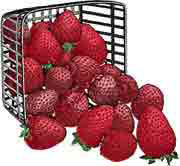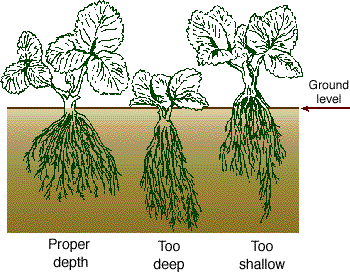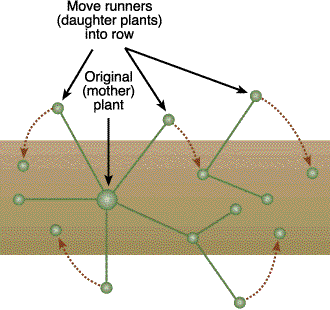
No fruit is more likely to provide home gardeners with success and satisfaction than strawberries. Strawberries are well adapted to our climate, require a very small investment, and will produce a good crop of fruit within 13 months of planting. Strawberry plants will bear every year if blossoms are protected from frost by mulching and will produce a good crop of berries for up to four years.
Before planting
Select the best site
Strawberries need full sun. Soil should have good surface and internal drainage. Ideally, the organic matter content should be about 5 percent, although strawberries will grow in soil that has as little as 2 percent organic matter.
Take a soil test
During the fall before planting, take a soil sample to your local MU Extension center and have it tested. If the soil test results indicate that additional nutrients are needed before planting, incorporate them in late winter. If the organic matter content is low, leaf mold, compost, rotted manure or aged sawdust can be incorporated to improve the soil tilth.
Decide how many to plant
You can expect to harvest about 1 quart of berries from each plant you set out plus its daughter plants if grown in a matted-row system. Twenty-five to 50 plants will provide plenty of fresh berries for a family of four. For freezing berries, set out an additional 50 to 100 plants.
Purchase well-adapted cultivars
Many strawberry cultivars are suitable for growing under Missouri conditions.
In selecting varieties, consider these attributes:
- Disease resistance
- Dessert and freezing quality
- Yield
- Season of ripening
Always purchase new plants rather than getting plants from neighbors or relatives. New plants are certified to be free of disease and should be free of viruses, whereas those obtained from a neighbor may harbor disease and insect pests. Buy your plants from a nursery with a good reputation. Consult your neighbors to see what their experience has been with various nurseries. If you are the first in your area to order strawberries, look at catalogs from a variety of nurseries. Do they guarantee disease-free plants? What is their policy if you get poor-quality plants from them? Do their descriptions give cultivar limitations as well as positive traits? Do their prices seem fair? Within reason, paying a little more for high-quality plants is always better than spending less for weaker plants.
Popular and better-adapted varieties for Missouri
This list is not intended to include all varieties that will grow in Missouri.
Earliglow
Earliglow is an early-season cultivar that produces berries that have outstanding flavor. Fruit is attractive with high quality, and freezes very well. The primary berries are medium-sized and secondary berries are small. Plants are vigorous and usually winter hardy. It shows resistance to leaf and root diseases.
Annapolis
Annapolis has vigorous plants that produce high yields of large, early season fruit. Berries are light red and firm with good flavor. Fruit size is maintained throughout harvest season. Plants are winter hardy and resistant to red stele disease, but are susceptible to leaf spot and powdery mildew.
Honeoye
Berries of Honeoye are medium-large and bright red but sometimes lack good flavor. High yields are harvested in early midseason. Plants are tolerant of most foliage diseases but not resistant to red stele or verticillium wilt. Berries are excellent for freezing. Plants are winter hardy.
Redchief
Redchief berries are medium-large and sweet with exceptional quality. This cultivar is resistant to five strains of red stele root disease and verticillium wilt, but is susceptible to leaf spot. It produces runners freely, and the fruit is harvested in early midseason. Berries are excellent for freezing.
Surecrop
Surecrop has large, light-colored berries that are tart with fair quality. This is one of the most productive, vigorous and disease-resistant cultivars available. Berries ripen in early midseason.
Allstar
Allstar berries ripen in late midseason. They are large, glossy, orange-red, firm and very good quality for fresh eating. Allstar is resistant to red stele and verticillium wilt and is tolerant of leaf diseases.
Chandler
Chandler is a midseason cultivar adapted to matted-row and other production systems in southern locations. Fruit are large and firm with good flavor. Plants are susceptible to anthracnose rots.
Jewel
Jewel plants produce high yields of large wedge-shaped fruit with good firmness and very good flavor. Berries ripen in late midseason. Plants should be hardy in most Missouri winters, but runners do not grow excessively. It has some resistance to leaf diseases but no resistance to red stele or verticillium wilt.
Lateglow
Lateglow is a late-season cultivar with high yield potential. Fruit are very large with excellent firmness and very good flavor. Roots are resistant to red stele but susceptible to powdery mildew. Plants will tolerate most Missouri winters.
Sparkle
Sparkle produces fruit that ripens late in the season. Berries tend to be soft and medium-sized, but have very good flavor. Plants bloom late, so they may escape spring frost injury. Plants are resistant to the most common strain of red stele, but susceptible to leaf diseases and verticillium wilt.
Everbearing and day-neutral cultivars
Traditional everbearing cultivars do not produce fruit continuously throughout the growing season. They tend to produce a crop in the spring and a small crop in the fall, with little or no crop in between. Everbearing plants require a short day-length to set fruit buds.
Day-neutral cultivars can potentially produce flower buds regardless of day-length, and fruit can be harvested in the summer and fall. However, these cultivars do not initiate floral buds when the temperature exceeds 85 degrees Fahrenheit. Tribute plants produce moderate to high yields. Berries are medium to large and have excellent firmness and very good flavor. Plants have good winter hardiness, are resistant to red stele and verticillium wilt, and are tolerant of the leaf diseases. Tristar plants produce moderate yields. Berries are small to medium and have excellent firmness and outstanding flavor. These plants have good winter hardiness, are resistant to red stele and verticillium wilt, and are tolerant of the leaf diseases. Seascape is another day-neutral cultivar that can bear fruit 12 to 14 weeks after planting.
At planting

Plant as early as soil is workable in the spring — early March to early April. Test for workability by digging a shovelful of soil and tightly squeezing a handful. Does the ball of soil break easily? If so, it is ready to till. Add 10 pounds of 5-10-5 or 8-24-8 fertilizer per 1,000 square feet and work it into the upper 3 to 4 inches of soil. Plants can now be transplanted.
Space rows 42 to 48 inches apart; plants in the row should be spaced 30 to 36 inches apart.
When setting out plants
- Keep the roots moist at all times.
- Spread roots out in hole.
- Plant at proper depth (Figure 1).
- Water plants (you can add 1 tablespoon of a water-soluble fertilizer per gallon of transplant water).
First-year care
Remove blossoms
Remove blooms on newly planted strawberries. If berries are allowed to develop, they deplete the food reserves of the plant and delay runner production.
Cultivate
Perhaps the most important practice in a new strawberry planting is cultivation. For the first six weeks or so it should be frequent — perhaps once a week. Culivation has two benefits:
- It kills weeds.
- It loosens soil for better runner penetration.
If necessary, herbicides can be an effective tool in controlling weeds in strawberries.
Train runners
To establish manageable rows, train runners to root in the row rather than the aisle between rows (Figure 2).

Irrigate
Strawberries can survive all but the most severe drought periods. However, irrigate to get the highest yields of large berries. Strawberries should have a minimum of 1 inch of water per week — more during prolonged hot, dry periods. A simple rain gauge will determine weekly rainfall. Irrigate to make up for rainfall deficiencies.
Mulching
Winter mulch is used to prevent alternate freezing and thawing of the soil that heaves plants out of the bed. Other benefits of mulching include improved control of weeds and grass, protection from severe cold temperatures, and cleaner berries at harvest.
Kinds of mulches
Many materials can be used for mulching; in Missouri the two most commonly used are straw and aged sawdust. Obtain straw shortly after wheat harvest. Loosen bales, and soak with water. This treatment along with rains that follow should germinate most of the grain before it is time to apply the straw.
When to apply mulches
Apply straw mulch in late November or early December — after a few days of temperatures down to 20 degrees Fahrenheit. Straw should be sifted loosely over the plants, just enough to cover them from view. After a week of settling, add additional straw where necessary.
When sawdust is used for a mulch, try to maintain a 1-inch mulch depth. No additional winter protection is needed.
Second- and third-year care
Remove mulch
Remove straw mulch in the spring as the weather begins to warm and before bloom. Check closely after each warm period from late February through March; if the strawberry foliage begins to show yellowing, remove the mulch. Rake mulch toward row aisles, but leave a light sprinkling on the plants — they will push through. If spring frosts threaten, rake the mulch back over the plants, but be sure to rake off the mulch during the day.
Control insects and diseases
Many pest problems can be avoided by using good cultural practices as described above. When insects or diseases can no longer be controlled culturally, pesticides may be applied.
Harvest
Pick berries daily if possible, and pick all berries that are ripe. Toss out all moldy berries; doing so will help prevent rots from spreading.
Renovate and fertilize
After harvest, decide what to do with your strawberry bed. The two options are described below.
Simply re-fruit the bed by renovating the plants immediately after harvest. First, remove weeds from row middles. Next, mow old tops off of the strawberry plants to renovate or renew the bed. Set lawn mower high enough to remove strawberry leaves but not injure crowns. Then use a rototiller or spade to narrow each plant row to a 6-inch width. This sounds drastic, but do it. Runner plants from the 6-inch strip of "mother" plants will form a new matted row of plants. Apply 5 pounds of 5-10-5 fertilizer per 100 feet of row (10 pounds if sawdust is used as a mulch). Apply about 11/2 to 2 inches of water a week to the strawberry bed during June, July and August (include rainfall in water total). To prevent overcrowding of plants and reduce the incidence of leaf diseases, thin plants to 5 to 7 plants per square foot. This method of renovation can be used to fruit the strawberry bed for a total of three or four years. During the rest of the growing season, irrigate to provide 1 inch of water per week, and continue to control weeds.
Replant beds after harvesting berries for three or four years. After a few years, strawberry plants tend to become infected with several leaf diseases and have declining yields. When plants become infected, they may be removed and a different crop can be planted on the site. Establish a new strawberry bed the next spring on a site where a different crop was previously planted. To avoid infecting new strawberry plants with verticillium wilt, do not plant them where tomatoes, potatoes, peppers, eggplant, okra, raspberries or vine crops were planted within the previous three years.
Diseases
Black root rot
Black root rot is caused by soil fungi, nematodes, winter injury, fertilizer burn, drought, too much water or any combination of these. Plants show poor vigor, produce few runner plants and may die in patches. Roots may be spotted with black zones or lack feeder roots, or the entire root system may be killed. Infected roots are black when cut in a cross section. There is no way to control black root rot. However, proper cultural practices that minimize plant stress should limit this disease. If a bed becomes infected with black root rot, plant a new bed in different location, and use only healthy, white-rooted plants.
Red stele root rot
Red stele root rot is caused by a soil-borne fungus and occurs most frequently on poorly drained sites with clay soils. The fungus is most active in the spring and fall when soils are cold and wet. Small feeder roots are killed, giving a "rattail" appearance. Main roots that are infected have rusty-red color in the core or stele. Plants may wilt and die during hot, dry conditions. To avoid this disease, plant only red stele-resistant varieties and plant in a well-drained site in a loamy soil.
Leaf spot and leaf scorch
Leaf spot and leaf scorch are two common foliage diseases. Leaf spot produces spots ¹/8 to 1/4 inch in diameter with purple borders and light gray centers. Leaf scorch produces small solid-purple spots with rather undefined borders. When numerous, they almost cover the entire leaf. Cultivars vary considerably in tolerance to these diseases. Foliar-applied fungicides aid in the control of these diseases.
Verticillium wilt
Verticillium wilt is caused by a soil-borne fungus. In new strawberry plantings, symptoms appear about the time runners start to grow. In established plantings, symptoms appear when the berries ripen. Older outer leaves of infected plants wilt, turn brown around the edges and between the veins, and eventually die. Petioles of the leaves may also turn red. Few new leaves develop, and new roots that grow from the crown are short and have blackened tips. To avoid this disease, select resistant strawberry cultivars and avoid sites that were previously planted with wilt-susceptible crops.
Gray mold
Gray mold is caused by the fungus Botrytis, which overwinters on plant debris on the ground. During bloom the fungus may be spread to blossoms during rainy weather, and the infection then spreads to the developing fruit. This disease often occurs where a dead petal or leaf adheres to the fruit or where a berry touches the soil. The disease appears as a gray, fuzzy mass of fungal spores on berries. To prevent this disease, thin plants to improve air circulation within the bed and use straw mulch. Fungicides may also be applied.
Leather rot
Leather rot is caused by a fungus that infects the berries when ripening fruit clusters are in contact with the soil or standing in water after a period of warm, rainy weather. Infected immature fruit turns brown. On ripening fruit, the color becomes bleached out, and infected areas are tough and dry. Berries taste bitter and smell rotten. A single infected berry can ruin the flavor of a whole jar of jam. To prevent this disease, use a mulch to minimize rain splash onto the fruit, or fungicides may be applied.
Viruses
Viruses may stunt plant growth or cause mottling or curling of leaves. They are introduced by insects such as aphids or leafhoppers. To prevent viruses, use certified plants and control these insects.
Insects and other pests
Tarnished plant bugs
Tarnished plant bugs cause deformed or "nubbin" berries with seeds concentrated at the tip of the fruit. Nymphs puncture individual seeds and inject a toxin so that the fleshy part of the berry stops developing where the seed was injured. Damaged seeds are hollow and turn a straw-brown color. Plant bugs are often in alfalfa; to prevent the bugs from feeding on strawberries, avoid mowing alfalfa when strawberry plants are in bloom.
Leafrollers
These small caterpillars (up to ½ inch long at maturity) roll the leaves together and feed on them. Leafrollers must be controlled if they become numerous.
Mites
Tiny, spiderlike creatures, mites are typically found on the underside of leaves. They tend to be the most damaging during hot, dry periods, when they suck plant juices from the leaves.
Spotted wing drosophila
Spotted wing drosophila is a fruit fly that was first detected in Missouri fruit crops in 2013. Small adult flies lay eggs in fruit, and developing larvae infest ripening berries. Removal of infested fruit from the planting and burial or disposal in a closed container will help limit future infestations.
Strawberry weevils or clippers
Weevils and clippers puncture fruit buds with their snouts to feed on immature pollen. Later, females deposit an egg inside a floral bud and girdle the petiole of the bud so that it falls to the ground or is left hanging by a small bit of tissue.
Slugs
Dark gray, black or brown slugs eat holes in ripe fruit and are worse during rainy weather or near rotting foliage. Shiny slime trails are evidence of slugs.
Nematodes
Nematodes are worms that are too small to be seen with the naked eye. They live in the soil and mostly feed on roots. Symptoms of nematode damage include galls on the roots or stubby, stunted roots. To avoid a buildup of nematodes, rotate plantings to a different site when establishing new beds.
Causes of malformed fruit
"Nubbins" or "button berries" may be caused by feeding tarnished plant bugs, heavy infestations of cyclamen mites, frost injury, nutrient deficiencies (boron or calcium), inadequate pollination, abnormally high temperatures that make pollen nonviable, or the application of 2,4-D from Aug. 1 to Nov. 1, when fruit buds are forming.
Fasciated berries, those that have a cockscomb shape as if several berries have grown together with multiple tips, are caused by short day-lengths in the fall or by cold, dry weather during this time. Fasciated fruit often occurs when cultivars adapted to northern conditions are grown in the south.